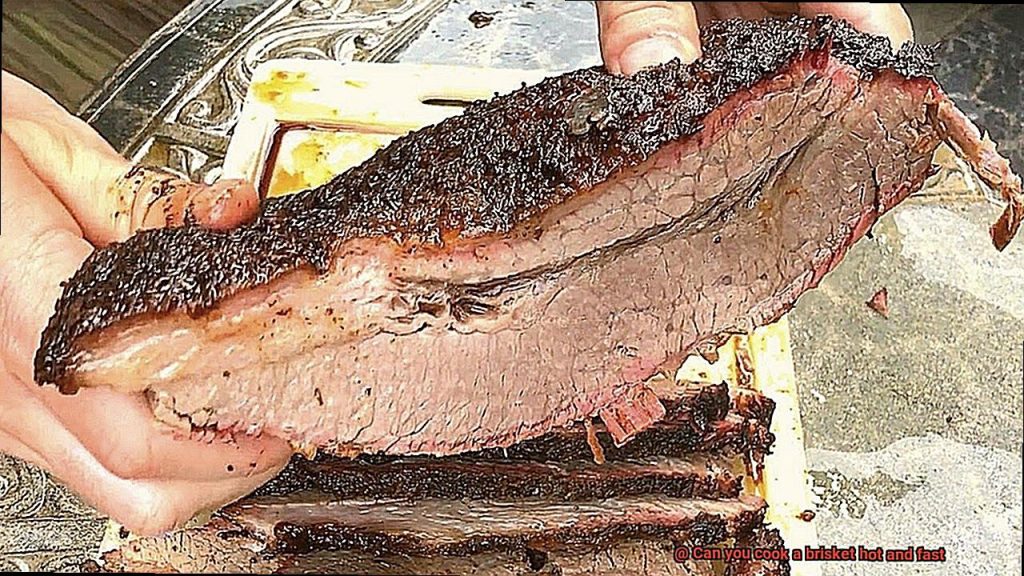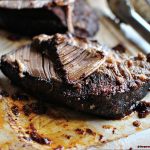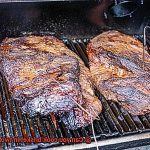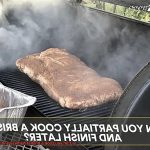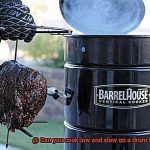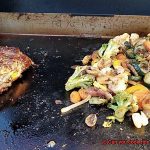Imagine this: a juicy, tender brisket that’s bursting with flavor, ready to be devoured in just a few short hours. It may sound like a wild culinary experiment, defying the traditional low and slow cooking approach. But let me assure you, my fellow foodies, cooking a brisket hot and fast is not only possible but can also yield incredible results.
So get ready to embark on a bold journey into the world of hot and fast brisket cooking. In this blog post, we’ll unravel the mysteries behind this unconventional technique and guide you through the steps to unlock an explosion of taste while slashing your cooking time. Whether you’re a grill master looking to take your skills to new heights or simply craving an exciting twist on a classic dish, prepare yourself for an epic flavor adventure with the hot and fast method. Get ready to ignite your taste buds as we dive headfirst into this sizzling culinary escapade.
Contents
What is Hot and Fast Brisket Cooking?
Hot and fast brisket cooking has gained popularity among grilling aficionados for its ability to deliver succulent, flavorful brisket in a fraction of the time compared to traditional low and slow methods. In this article, we will explore the concept of hot and fast brisket cooking, its benefits, and how to achieve mouthwatering results.
The Technique:
Hot and fast brisket cooking involves roasting the brisket at higher temperatures (around 300-350 degrees Fahrenheit) for a shorter period of time. This higher heat allows for a quicker cooking process, reducing the overall cooking time by several hours. The goal is to achieve a tender and juicy brisket while also developing a well-browned crust on the outside, known as the bark.
Benefits of Hot and Fast Brisket Cooking:
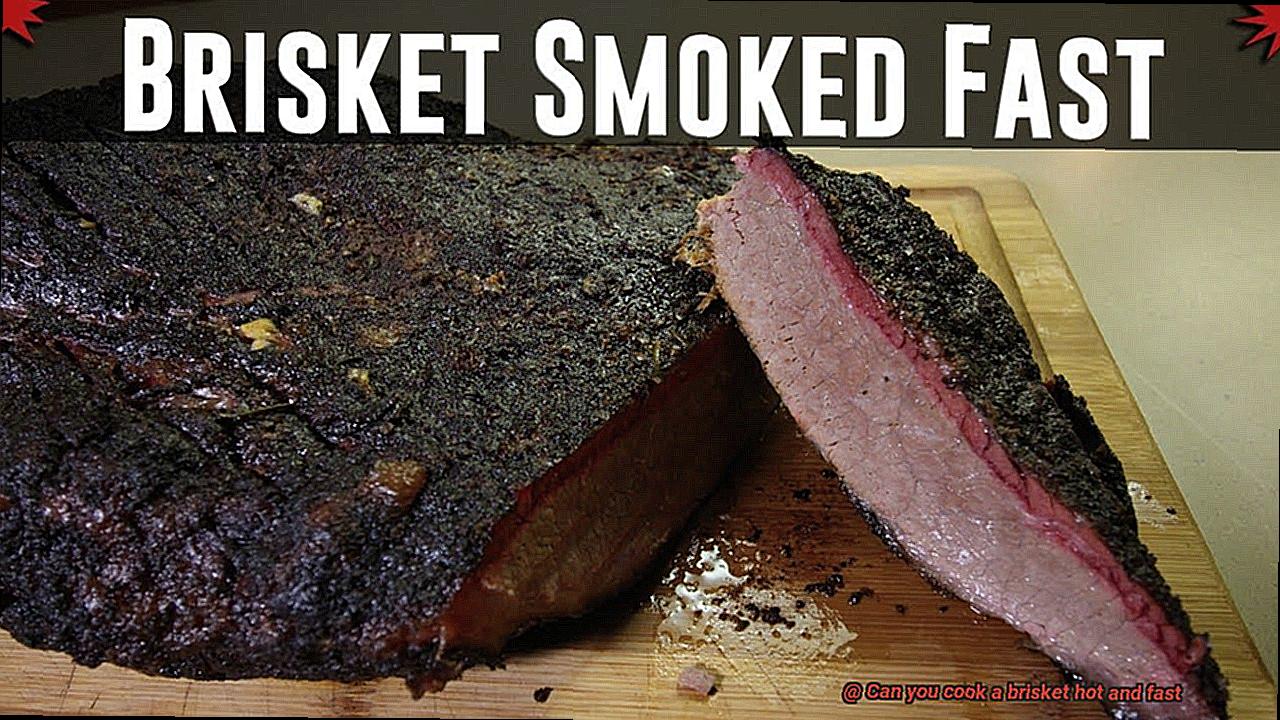
- Time Efficiency: Say goodbye to spending 14 hours or more tending to your smoker. With hot and fast cooking, you can enjoy mouthwatering barbecue in as little as 4-6 hours, making it perfect for those with limited time.
- Crispy Bark: The higher temperatures used in hot and fast cooking promote better caramelization, resulting in a flavorful crust on the outside of the brisket. This crispy bark adds depth and texture, creating a delightful contrast with the tender meat.
Tips for Successful Hot and Fast Brisket Cooking:
- Choose the Right Cut: Opt for smaller cuts or select-grade briskets when using the hot and fast method. These cuts cook faster and are less likely to dry out during the shorter cooking time.
- Maintain Consistent Temperature: Use a reliable smoker or grill with good temperature control to ensure a consistent heat throughout the cooking process. Fluctuations in temperature can affect the cooking time and result in unevenly cooked brisket.
- Monitor Internal Temperature: Hot and fast cooking requires more attention and monitoring compared to low and slow methods. Keep an eye on the internal temperature of the brisket to avoid overcooking or drying it out.
- Experiment and Adjust: While hot and fast cooking can produce delicious results, it may not always match the tenderness and flavor of traditional low and slow methods. Experiment with both techniques to find the one that suits your taste and cooking style best.
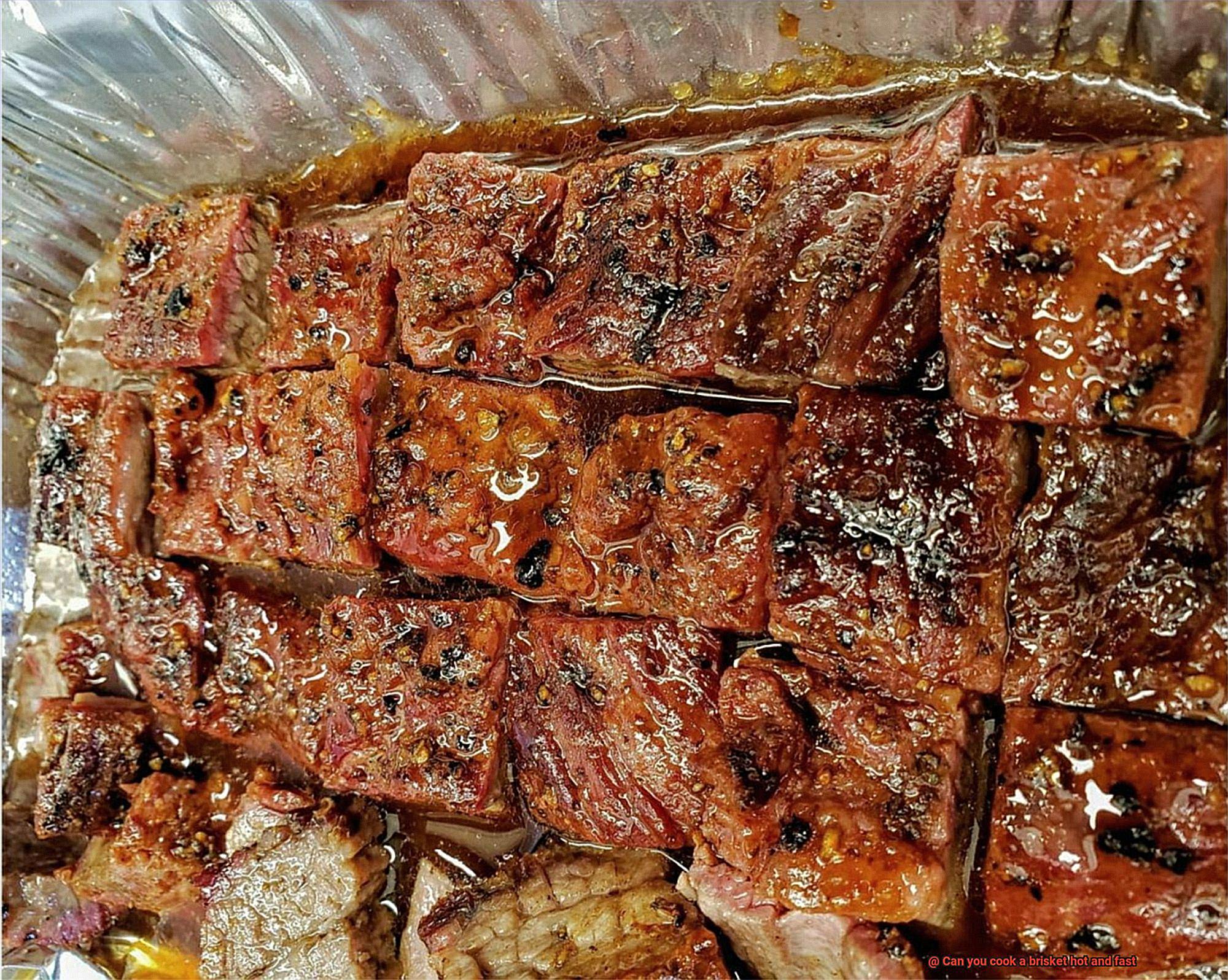
Advantages of Hot and Fast Brisket Cooking
If you’re tired of spending endless hours by the smoker, waiting for that perfect brisket to cook low and slow, then listen up – hot and fast brisket cooking is here to save the day. This method of grilling brisket at higher temperatures for a shorter period of time has been gaining popularity among BBQ aficionados, and for good reason. Let’s dive into the advantages of hot and fast cooking that will have you firing up your grill in no time.
First and foremost, let’s talk about time efficiency. We all lead busy lives, and sometimes we just don’t have the luxury of spending all day tending to the grill. With hot and fast cooking, you can have a perfectly cooked brisket on your plate in a fraction of the time. No more waiting around for hours on end – this method will have you enjoying a delicious brisket even on a weeknight.
Now, I know what you’re thinking – does hot and fast cooking compromise on flavor? Absolutely not. In fact, it can actually enhance the flavor profile of your brisket. The higher temperatures used during this cooking method promote caramelization on the surface of the meat, creating a savory crust that locks in juices and imparts a rich smoky flavor. Plus, the shorter cooking time helps retain more of the natural juices within the meat, resulting in a moist and succulent final product. Who can resist that?
But it’s not just about flavor – texture matters too. While low and slow cooking can sometimes result in mushy meat, hot and fast cooking allows you to achieve a desirable toothsome texture. The higher heat encourages better rendering of fat, leading to a crispy exterior while maintaining a tender interior. It’s all about that perfect balance between crispy and juicy that will have your taste buds dancing with joy.
Hot and fast cooking also offers greater versatility when it comes to experimenting with flavors and seasonings. Since the cooking time is significantly reduced, you have less risk of overpowering the meat with strong marinades or rubs. This means you can get creative and try out different seasoning combinations, creating unique and personalized flavors that suit your taste preferences. The sky’s the limit.
And let’s not forget about the ease of preparation. Hot and fast cooking is a more convenient option for those who are new to grilling or have limited experience with low and slow methods. The shorter cooking time reduces the margin for error, making it easier to achieve consistent results. Plus, you’ll have less monitoring and attention to worry about, giving you more flexibility and freedom during the cooking process. It’s a win-win situation.
Choosing the Right Cut of Brisket
When it comes to grilling brisket, choosing the right cut is crucial for achieving the perfect balance of tenderness and flavor. The two main types of brisket cuts are the point cut and the flat cut, each with its own unique characteristics.
The point cut, also known as the deckle, is a thicker and fattier section of the brisket. It boasts more marbling, which translates to more flavor and tenderness. This cut is ideal for slow cooking methods such as smoking or braising, as the extra fat content keeps the meat moist and juicy throughout the long cooking process.
On the other hand, the flat cut is leaner and has less marbling. It is a flatter and more rectangular piece of meat, making it easier to slice or chop into uniform portions. The flat cut is often preferred for dishes like sliced brisket sandwiches or chopped brisket tacos.
When choosing a brisket, consider both the size and quality of the cut. Briskets can range in size from 8 to 20 pounds, with smaller cuts being easier to handle and cook more evenly. Larger cuts may require longer cooking times and increased attention to prevent drying out.
Inspecting the overall quality of the brisket is also important. Look for a cut that has a good amount of fat evenly distributed throughout the meat. This fat will render during cooking, adding moisture and flavor to the final product.
Lastly, consider your grilling method when selecting a brisket. If you prefer hot and fast cooking, where higher temperatures are used for quicker cooking times, a well-marbled point cut may be your best option. The additional fat will help keep the meat moist and tender during this faster cooking process. However, if you enjoy low and slow cooking methods like smoking, both point and flat cuts can produce excellent results with proper preparation and handling.
Temperature Control for Hot and Fast Brisket Cooking
Hot and fast brisket cooking is an exciting and intense method that requires precise temperature control to achieve that mouthwatering, tender brisket you’ve been craving. So buckle up, because we’re about to dive into the world of temperature control for hot and fast brisket cooking.
To start off, it’s crucial to preheat your grill or smoker to a scorching 325°F (163°C). This high heat acts as the catalyst for the searing process, locking in those rich flavors that will make your taste buds dance with delight. Don’t forget to equip yourself with a reliable digital thermometer with probe inserts to keep a watchful eye on the internal temperature of the brisket as it cooks.
Now let’s talk about temperature control. It’s like playing with fire – quite literally. One method is adjusting the airflow in your grill or smoker. Opening the vents will stoke the flames and raise the temperature, while closing them will tame the inferno and bring it down a notch. It’s a delicate balancing act that requires finesse and intuition.
But why stop there? Another ace up your sleeve is using a water pan. Simply place this magical contraption in your grill or smoker, and watch as it becomes the conductor of heat. Acting as a heat sink, it absorbs and releases heat as needed, helping you maintain that steady, controlled temperature throughout the cooking process. No more sudden spikes or drops to ruin your masterpiece.
As you embark on this culinary journey, remember to monitor the temperature regularly and make adjustments as needed. Precision is key when it comes to achieving that perfect hot and fast brisket.
Finally, when your brisket reaches an internal temperature of around 195°F (90°C), it’s time to unleash it from its fiery chamber and let it rest. Yes, patience is required here. Allowing the brisket to rest allows those precious juices to redistribute, resulting in a more succulent and tender end product. It’s like a symphony of flavors coming together, creating a masterpiece worth savoring.
Monitoring the Internal Temperature of the Brisket
Embark on this journey with me as we uncover the importance of this practice and unlock the secrets to achieving BBQ greatness.
Imagine a secret window, a glimpse into the tenderness and juiciness that lies within your brisket. That’s precisely what monitoring the internal temperature provides—a gateway to culinary perfection. So, let’s delve deeper into this art form.
First and foremost, you’ll need a trusty companion in the form of a meat thermometer. There are countless options out there, but allow me to steer you towards either an instant-read or leave-in thermometer. The former grants you quick and accurate readings when plunged into the heart of the brisket, while the latter remains nestled within the meat throughout the grilling process, offering convenience beyond measure.
Here’s a pro tip: ensure your thermometer is inserted into the thickest part of the brisket, far from any bones or fat. This guarantees accurate readings devoid of interference. After all, false readings have no place in our quest for perfection.
As your brisket dances upon scorching grates, it is vital to check the internal temperature at regular intervals. This allows you to gauge the progress and make any necessary adjustments to maintain a steady temperature. Ah, but don’t forget—the different parts of your brisket may cook at slightly varying rates. Thus, be diligent in checking multiple spots for an accurate average reading.
Now, let’s discuss numbers—the language of precision. When undertaking the hot and fast method, aim for an internal temperature between 195°F (90°C) and 205°F (96°C). Within this range lies the key to tender, succulent bliss. Yet, remember that each brisket possesses its unique character—size, thickness, and fat content all influencing cooking time and internal temperature. Hence, trust in your thermometer as the ultimate arbiter of doneness, disregarding the confines of mere cooking time.
Comparing Low and Slow vs Hot and Fast Brisket Cooking
Get ready to dive into the age-old debate of low and slow cooking versus hot and fast cooking methods. Grab your apron and let’s explore the key differences between these two approaches to grilling perfection.
Let’s start with the traditional method: low and slow cooking. Picture this – your brisket slowly cooking at a low temperature, around 225-250°F, for a whopping 12-14 hours. It’s a test of patience, but oh-so-worth it. This method allows the collagen in the meat to break down gradually, resulting in a tender and juicy brisket that melts in your mouth. And the flavors. The long cook time allows the rub and smoke to permeate every fiber of the meat, creating a rich and smoky flavor that will make your taste buds dance with delight.
Now, let’s turn up the heat with hot and fast cooking. This method is all about speed without sacrificing tenderness or flavor. Imagine cranking up the temperature to 300-350°F and cooking your brisket for a shorter period of time, about 6-8 hours. It’s a favorite among professional pitmasters who need to produce mouthwatering brisket in a pinch.
With careful temperature management and constant attention, you can achieve a crispy bark on the outside of your brisket that adds an irresistible texture to each bite. The higher temperature also creates those savory caramelized flavors through the Maillard reaction, giving your brisket an extra layer of deliciousness.
But what are the downsides? Well, low and slow cooking requires a significant amount of time, which may not be feasible for everyone. On the other hand, hot and fast cooking may not allow enough time for the collagen to fully break down, resulting in a slightly less tender brisket compared to its low and slow counterpart. Additionally, you might miss out on some of that deep smoke flavor that develops over a longer cook time.
So how do you choose between these two methods? Ultimately, it comes down to personal preference and circumstances. If you have the time and patience, low and slow cooking can yield a melt-in-your-mouth brisket with a robust smoky flavor. However, if you’re short on time or prefer a crispy bark, hot and fast cooking may be your go-to.
Tips for Successful Hot and Fast Brisket Cooking
Look no further than hot and fast brisket cooking. This technique allows you to achieve mouthwatering, tender brisket in less time. In this article, we will share expert tips to help you master the art of hot and fast brisket cooking.
Properly Prepare the Brisket:
The first step to success is proper preparation. Choose a well-marbled brisket with good fat distribution to keep the meat moist during the faster cooking process. Trim excessive fat, leaving about ¼ inch for flavor and moisture retention. Next, season the brisket generously with your choice of dry rub or marinade to enhance flavor and create a flavorful crust.
Preheat Your Grill:
To achieve hot and fast cooking, preheat your grill or smoker to a high temperature, around 325-350°F. Make sure you have enough fuel or charcoal to maintain this temperature throughout the cooking process. This initial blast of heat will help sear the outside of the brisket, locking in those delicious juices.
Monitor Internal Temperature:
A key element of hot and fast cooking is monitoring the internal temperature of the brisket. Use a digital meat thermometer to ensure accuracy. For optimal tenderness, aim for an internal temperature of around 195-205°F. Be vigilant and avoid overcooking by keeping a close eye on the temperature.
Maintain Moisture:
One challenge of hot and fast cooking is preventing the brisket from drying out. Consider using a water pan or spritzing the brisket with liquid such as apple juice or beef broth during cooking. This simple step will keep the meat moist and add an extra layer of flavor.
Rest Before Slicing:
After the intense cooking process, it’s crucial to let the brisket rest before slicing. Allow it to rest for at least 30 minutes, wrapped in aluminum foil. This resting period allows the juices to redistribute within the meat, resulting in a more tender and flavorful final product.
Slice Against the Grain:
When it’s time to slice the brisket, remember to cut against the grain. By cutting perpendicular to the long muscle fibers of the meat, you maximize tenderness and create a melt-in-your-mouth experience. Serve immediately and savor the fruits of your labor.
OINOi5vPQbE” >
Conclusion
In conclusion, the art of cooking a brisket hot and fast is not only possible but can also lead to mouthwatering results that will leave you craving more. This unconventional approach involves subjecting the brisket to higher temperatures (around 300-350 degrees Fahrenheit) for a shorter duration. The benefits of this method are twofold: it saves precious time, with a cook time as little as 4-6 hours compared to the traditional 14-hour low and slow method, and it creates a tantalizing crust on the outside known as the bark.
To master the art of hot and fast brisket cooking, you must first select the right cut. Opt for smaller cuts or select-grade briskets that cook faster and are less prone to drying out. Temperature control is key, so make sure you have a reliable smoker or grill at your disposal with excellent temperature regulation capabilities. And don’t forget to keep an eagle eye on the internal temperature of the brisket throughout the cooking process to avoid any mishaps.
While hot and fast cooking can deliver delectable results, it’s important to note that it may not always match up to the tenderness and flavor achieved through traditional low and slow methods. To truly find your culinary sweet spot, I encourage you to experiment with both techniques. Let your taste buds be your guide as you embark on an epic flavor adventure with hot and fast brisket cooking.
So why wait?

